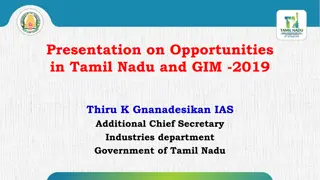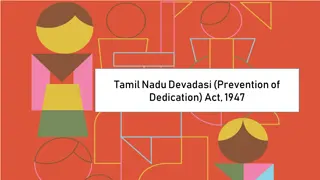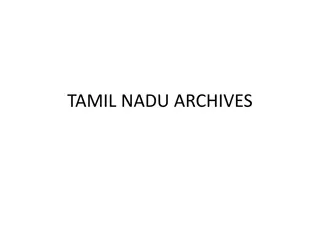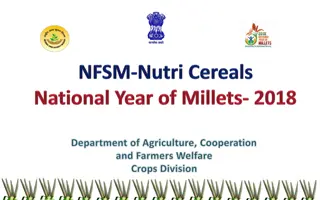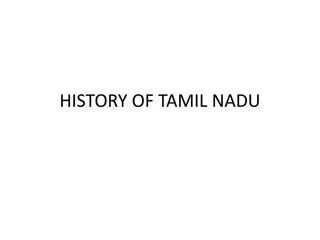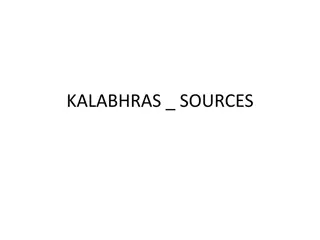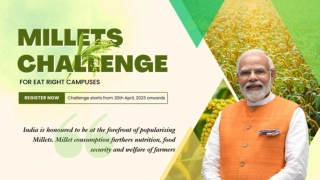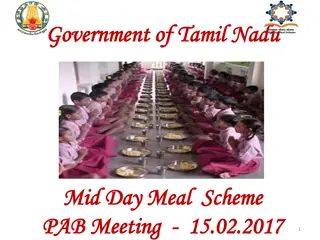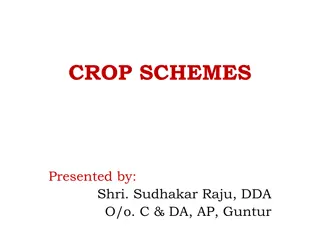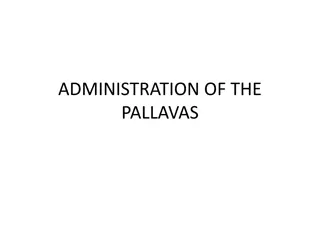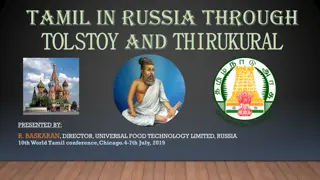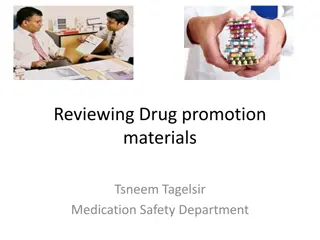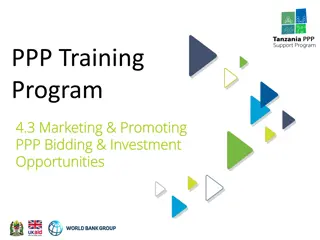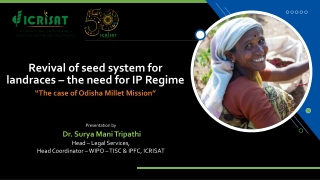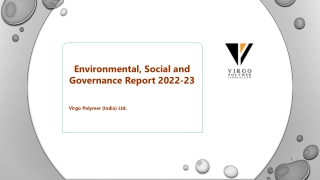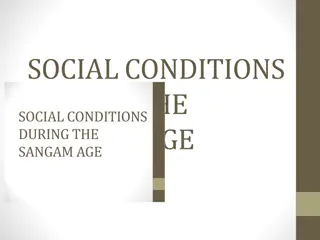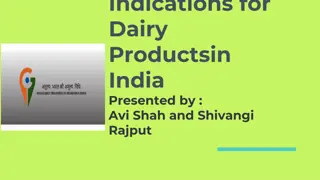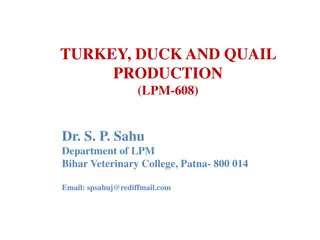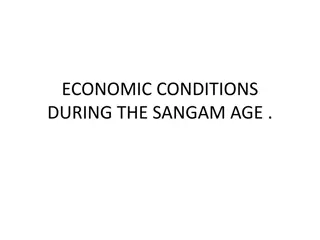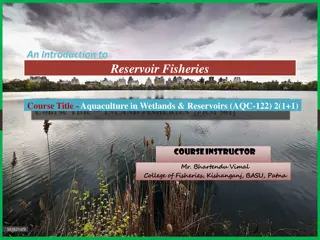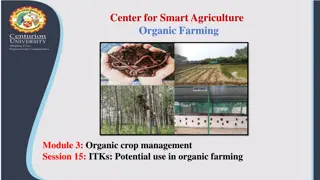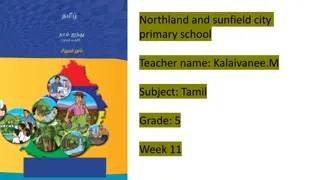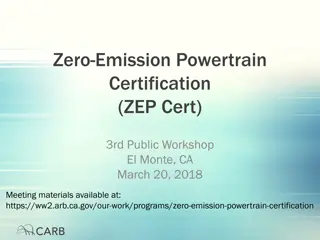Promotion of Millets in Tamil Nadu - National Workshop Highlights
A national-level workshop on the promotion of millets was held on 28th September 2018 at Vaikunth Mehta National Institute of Cooperative Management in Pune. The workshop aimed to highlight the significance of millets in the agricultural scenario of Tamil Nadu, showcasing their superior nutritional characteristics and their potential in food security. The event featured key figures like George Mammen, Deputy Director of Agriculture, and T. Thanasekaran, State Level Consultant. Tamil Nadu's position in various crops at the national level was discussed, emphasizing the state's reliance on agriculture as a major livelihood provider. Moreover, the importance of millets for sustainable farming practices was underscored, given their low input requirements and benefits for small and marginal farmers.
Download Presentation

Please find below an Image/Link to download the presentation.
The content on the website is provided AS IS for your information and personal use only. It may not be sold, licensed, or shared on other websites without obtaining consent from the author. Download presentation by click this link. If you encounter any issues during the download, it is possible that the publisher has removed the file from their server.
E N D
Presentation Transcript
PROMOTION OF MILLETS IN TAMILNADU NATIONAL LEVEL WORKSHOP ON MILLETS DATE: 28.09.2018 DATE: 28.09.2018 VENUE:Vaikunth Mehta National Institute of Cooperative Management(VAMNICOM).Pune George Mammen. Deputy Director of Agriculture(Paddy& Millets) T.Thanasekaran . State Level Consultant(NFSM) Directorate of Agriculture.Chennai
AGRICULTURE SCENARIO Geographical area Gross area sown Net area sown Gross Area Irrigated Net Area Irrigated Rainfed Average Rainfall - 13.033 M.ha. - 6.074 M.ha.(47%) - 4.833 M.ha.(37%) - 3.575 M.ha (59%) - 2.833 M.ha (59%) - 2.499 M. ha -921 mm {National-1200mm} - 8.118 Million - 0.80 Ha. {National -1.15 ha.} - 92% (operating 61% area) - 8% (operating 39%area) No. of land holdings Average size of holding SF/MF Other Farmers
TAMILNADU POSITION AT ALL INDIA LEVEL All India Average Yield (Kg/ha) 2,557 Yield in Tamil Nadu (Kg/ha) Position of Tamil Nadu at National Level Crop Maize 5,360 1 Bajra Groundnut 1,272 1,400 2,881 2,699 1 1 Total Oilseeds 1,037 2,294 1 Cotton Rice 461 718 1 2 2,390 3,191 Sugarcane(MT) 70 93 3 Sunflower Jowar Coarse cereals 753 953 1,625 1,485 3,066 3 3 4 1,729 Food grains 2,070 2,529 5 Total Pulses 744 698 8
Agricultural Scenario Tamil Nadu has 4% of the land area and 3% of the water resources at National level. 92% of total land holdings in Tamil Nadu belong to Small and Marginal farmers. Agriculture is the major livelihood provider to about 40% of the population of Tamil Nadu Nearly 90% of underground water potential has been exploited Tamil Nadu depends on the performance of monsoons and release of water from Mettur Dam.
Significance of Millets The government of India has declared 2018 as the National year of Millets. Millets is one of the oldest food known to mankind. Millets hold enormous hope for food and nutritional security. They are predominantly grown in areas with low rainfall and contributes to food and fodder requirements. Millets need very little inputs for their sustenance and require only 25% of the water consumed by irrigated crops. Millets are a pest free crops and is highly suitable for organic farming.
Superior nutritional characteristics of millets Millets contain high amounts of proteins and fibre, B-complex vitamins including niacin, thiamine and riboflavin, the essential sulphur- containing amino acid methionine, lecithin and some vitamin E. Rich in iron, magnesium, potassium. Contain phyto-nutrients, including phytic acid, which is believed to lower cholesterol and phytate, which is associated with reducing risk of cancer. calcium and
Millet cultivating Districts in Tamil Nadu Sl. No 1. Name of the Crop Predominant district Jowar Salem, Coimbatore, Trichy, Karur, Tirupur, Namakkal, Dindigul, Virudhunagar, Theni 2. Bajra (Pearl millet) Villupuram, Thoothukudi, Madurai 3. Ragi (Finger millet) Dharmapuri, Krishnagiri, Salem 4. Maize Nammakal, Salem, Tiruppur, Erode, Perambalur, Ariyalur, Theni, Dindigul, Viruthunagar, Thoothukudi,Coimbatore Madurai, Virudhunagar. 5. Kudhiraivali (Barnyard millet) Varagu (Kodo millet) 6. Cuddalore, Villupuram 7. Samai (Little millet) Vellore, T.V.Malai, Dharmapuri, Krishnagiri Salem 8. Tenai (Fox tail millet) 9. Panivaragu (Proso millet) Salem
RULING VARIETIES Jowar Co(S) 28, K11, CSH 14 ,CoS 30,K12 Bajra ICMV 221,Co(cu)9 Co(cu)10,Dhansakthi GPU 67, Co 14, Co 13, MR1, Co15, Ragi Maize Co1, CoHM5 ,CoHM6 and Hybrids Little Millet Co4. Kodo Millet Co3, Co4. Foxtail Millet Co (Te)7, Co6. Proso Millet Co4.
CONSTRAINTS IN MILLET CULTIVATION Changes in the consumption pattern Erratic Rain Fall due to vagaries in Monsoon. Declining farm size Major area under rainfed condition and cultivation of poor yielding local varieties,. Non availability of High yielding Hybrids/HYV except Maize and Bajra. Farmers not able to obtain Remunerative price leading to lesser returns. Lack of awareness of Improved methods of Production & Technologies. Weak post harvesting & market linkages Lack of Public Procurement & Marketing. Declining investment in agriculture by Public & Private sectors
Year wise Food Grain Area and Production Area (M.Ha.) Prodn. (M.MT) Year (*) Krishi Karman Award for the Highest Production in the country (**) Krishi Karman Award for the Highest Pulses Production in the country (#) Krishi Karman Award for the Highest Coarse Cereals in the country (@) Krishi Karman Award for the Highest Production in the country 2009-10 3.034 7.505 Food Grain 2010-11 3.174 7.594 2011-12* 3.209 10.152 2012-13 2.648 5.605 2013-14 ** 3.475 11.002 2014-15 3.741 12.795 Food Grain 2015-16 # 3.755 11.370 2016-17 @ 2.946 5.238 2017-18 3.636 11.484
Millets Area Coverage and Production Programme 2018-19 Area Production (Lakh Mt) Crop (Lakh. Ha) Kharif Rabi Total Kharif Rabi Total Jowar 2.303 1.787 4.090 4.535 3.339 7.874 Bajra 0.320 0.411 0.731 0.759 0.880 1.640 Ragi 0.777 0.243 1.020 2.233 0.754 2.987 Maize 1.929 1.900 3.829 16.238 12.909 29.147 Minor Millet 0.265 0.065 0.330 0.306 0.047 0.353 Total Millet 5.594 4.406 10.00 24.071 17.929 42.00
STRATEGIES to increase the STRATEGIES to increase the production in MILLETS production in MILLETS Replacing the traditional long duration low yielding varieties with high yielding short duration varieties Bringing additional area of millets in the current fallow areas in a phased manner. Interventions - cluster demonstration, distribution of certified seeds of High Yielding Varieties, Seed drill sowing, Community sowing, Intercropping with pulses and local initiatives (Need based technologies) included under NFSM- coarse cereals & Nutricereals. Productivity enhancing Inputs - Liquid biofertilizer, Maize booster / plant growth regulator , MN Mixture & Biocides Direct Procurement centres to procure Millets. Financial assistance for Post Harvest Management and Value addition by establishment of modern millet based processing units. Seed Production through Seed Hubs.
SPECIAL INTIATIVES FOR INCREASING THE PRODUCTION AND FARMERS INCOME IN TAMILNADU ESTABLISHMENT OF TAMIL NADU STATE SEED DEVELOPMENT AGENCY Exclusively for Seed Production activities ensuring Farmers preferred quality certified seeds Fixation of uniform procurement and sale price MISSION ON SUSTAINABLE DRY LAND AGRICULTURE (MSDA) Focus to improve production and productivity of Millets, Pulses Oil seeds and Cotton Extented to 25 Lakh Acre of Dryland Cluster Approach COLLECTIVE FARMING Organizing small and marginal farmers into Farmers Interest Groups (FIGs) Farmer Producer Groups (FPGs) Federated into Farmer Producer Organizations (FPO/FPCs)
NFSM Coarse Cereals (Maize) 2018-19 Assistance per unit. In Rs Sl. No. Name of the Component Unit Physical Finance (Rs. in Lakh) Demonstrations 1. Demonstrations on Improved Packages (Maize) Demonstrations on Intercropping (i) Maize with Blackgram Ha Rs.6000 3000 180.000 (a) (b) Ha Rs.6000 400 24.000 (ii) Maize with Greengram Ha Rs.6000 400 24.000 Sub total 1 (b) 800 48.000 Total for Demonstrations(1a &1b) 228.000 Distribution of Certified Seeds - Hybrid Seeds of Maize Total NFSM - Coarse Cereals (Maize) Central share State share Qtl Rs.10000 982 98.200 2 326.200 195.720 130.480
NFSM Nutri - Cereals 2018-19 Assistance per unit. In Rs Finance (Rs. in Lakh ) Sl.No. Name of the Component Unit Physical Cluster Front Line Demonstrations (60:40) 5040 252.000 Ha Rs. 5000/ per ha 1. Distribution of Seed (60:40) 2 (a) Hybrid Seed of Nutritive variety b) HYVs Seed Certified Seed Production of HYVs Seed (< 10 years old varieties) (60:40) Integrated Nutrient Management (INM) (60:40) Integrated Pest Management (IPM) (60:40) Farm Implements & Equipments (60:40) Qtl Rs. 10000/qtl 311.85 31.185 4054.05 4074.00 93.555 122.220 Qtl 3. Rs. 3000/Qtl 24000 100.000 Ha 4. Ha Rs. 500/ha 28948 24.740 5. 6 7000 38.000 TOTAL 661.700
NFSM Coarse Cereals 2018-19 Assistance per unit. In Rs Finance (Rs. in Lakh ) Sl.No. Name of the Component Unit Physical Cluster Front Line Demonstrations (60:40) 3800 228.000 Ha Rs. 6000/ per ha 1. Distribution of Seed (60:40) 2 (a) Hybrid Seed of Maize Qtl Rs. 10000/qtl 982 98.20 TOTAL 326.200
IMPACT OF NFSM PROGRAMMES IMPACT OF NFSM PROGRAMMES 2011-12 2017-18 Area (L.Ha) Production (L.Mt) Area (L.Ha) Production (L.Mt) S.No Crop 1 Jowar 1.98 2.53 3.86 4.21 2 Bajra 0.47 1.14 0.69 1.65 3 Ragi 0.83 2.25 0.91 3.27 4 Maize 2.81 16.96 3.41 27.17 5 Foxtail Millet 0.01 0.00 0.02 0.01 6 Kodo Millet 0.04 0.08 0.02 0.03 7 Little Millet 0.20 0.25 0.17 0.19 8 Other millets 0.05 0.03 0.09 0.05 Total Millets 6.38 23.24 9.16 36.57
THANK YOU THANK YOU


